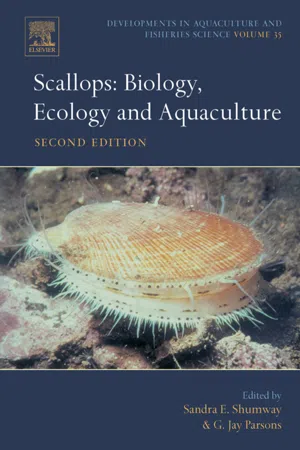
- 1,500 pages
- English
- PDF
- Available on iOS & Android
Scallops: Biology, Ecology and Aquaculture
About this book
Scallops are among the better known shellfish and are widely distributed throughout the world. They are of great economic importance, support both commercial fisheries and mariculture efforts and occupy a unique niche in the marine environment. Contributions from world leaders in scallop research and culture cover all facets of scallop biology including anatomy, taxonomy, physiology, ecology, larval biology and neurobiology. Chapters are also devoted to diseases and parasites, genetics, population dynamics and the adductor muscle, with extensive reference lists provided for each chapter. Since the publication of the first edition of Scallops: Biology, Ecology and Aquaculture in 1991, commercial interest in scallops has grown globally and this is reflected in the seventeen extensive chapters covering both fisheries and aquaculture for all species of scallops in all countries where they are fished or cultured. The Second Edition is the only comprehensive treatise on the biology of scallops and is the definitive reference source for advanced undergraduate and graduate students, mariculturists, managers and researchers. It is a valuable reference for anyone interested in staying abreast of the latest advances in scallops.* Offers over 30 detailed chapters on the developments and ecology of scallops* Provides chapters on various cultures of scallops in China, Japan, Scandinivia, Eastern North American, Europe, and Eastern North America* Includes details of their reproduction, nervous system and behavior, genetics, disease and parasites, and much more* Complete updated version of the first edition
Frequently asked questions
- Essential is ideal for learners and professionals who enjoy exploring a wide range of subjects. Access the Essential Library with 800,000+ trusted titles and best-sellers across business, personal growth, and the humanities. Includes unlimited reading time and Standard Read Aloud voice.
- Complete: Perfect for advanced learners and researchers needing full, unrestricted access. Unlock 1.4M+ books across hundreds of subjects, including academic and specialized titles. The Complete Plan also includes advanced features like Premium Read Aloud and Research Assistant.
Please note we cannot support devices running on iOS 13 and Android 7 or earlier. Learn more about using the app.
Information
Table of contents
- front cover
- Title page
- copyright
- front matter
- Dedication
- Preface
- Preface from first edition
- List of contributors
- Table of Contents
- body
- 1 New Phytogenies of the Pectinidae (Mollusca: Bivalvia): Reconciling Morphological and Molecular Approaches
- 2 Development, Physiology, Behaviour and Ecology of Scallop Larvae
- 3 Structure and Function in Scallops
- 4 Scallop Adductor Muscles: Structure and Function
- 5 Neurobiology and Behaviour of the Scallop
- 6 Reproductive Physiology
- 7 Physiology: Energy Acquisition and Utilisation
- 8 Physiological Integrations and Energy Partitioning
- 9 Nutrition in Pectinids
- 10 Genetics
- 11 Diseases and Parasites of Scallops
- 12 Scallop Ecology: Distributions and Behaviour
- 13 Scallops and Marine Contaminants
- 14 Dynamics, Assessment and Management of Exploited Natural Populations
- 15 Fisheries Sea Scallop, Placopecten magellanicus
- 16 Sea Scallop Aquaculture in the Northwest Atlantic
- 17 Bay Scallop and Calico Scallop Fisheries, Culture and Enhancement in Eastern North America
- 18 Scallops of the West Coast of North America
- 19 The European Scallop Fisheries for Pecten maximus, Aequipecten opercularis and Mimachlamys varia
- 20 European Aquaculture
- 21 Scandinavia
- 22 Japan
- 23 Scallop Culture in China
- 24 Scallops Fisheries and Aquaculture of Northwestern Pacific, Russian Federation
- 25 Scallop Aquaculture and Fisheries in Brazil
- 26 Argentina
- 27 Scallop Fishery and Aquaculture in Chile
- 28 Venezuela
- 29 Mexico
- 30 Scallop Fisheries, Mariculture and Enhancement in Australia
- 31 New Zealand
- indices